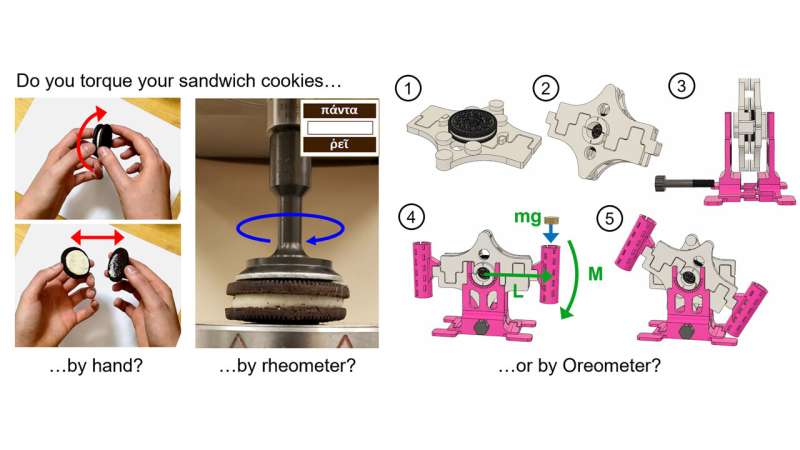Twisting Oreos shows creme filling sticks to one side

Imagine the perfect way to eat an Oreo. Perhaps you twist the top layer, separating the cookie into two parts, and then eat them one by one. Alternatively, you could dunk the treat into milk to soften it just the right amount. Or maybe, if you're a rheologist who studies complex fluids, you snack on the cookie while you test its mechanical properties in your lab.
In Physics of Fluids, researchers from Massachusetts Institute of Technology characterized the flow and fracture of Oreos, finding the creme, which is officially "mushy" in rheological texture, tends to stick to one side of the cookie.
"Rheology can be used to measure the texture of food depending on the failure stresses and strains," said author Crystal Owens. "We were able to characterize Oreo creme as quantitatively mushy."
They placed Oreos in a rheometer, a laboratory instrument they used to measure torque as it fixed one side of the cookie in place and carefully twisted the other. After the filling failed and the cookie broke apart, they quantified the amount of creme on each wafer by visual inspection.
"I had in my mind that if you twist the Oreos perfectly, you should split the creme perfectly in the middle," said Owens. "But what actually happens is the creme almost always comes off of one side."
The authors investigated the influence of milk, cookie flavor, amount of filling, and rotation rate on the final creme distribution. After being dipped in milk, the cookies degraded quickly, crumbling after about 60 seconds. Flavor and filling seemed to have little effect on cookie mechanics, but breaking the cookies apart cleanly did depend on the rotation rate.
"If you try to twist the Oreos faster, it will actually take more strain and more stress to break them," said Owens. "So, maybe this is a lesson for people who are stressed and desperate to open their cookies. It'll be easier if you do it a little bit slower."
The creme may stick consistently to one side because of the way the cookies are manufactured and then oriented during packaging. Cookies from the same box often followed the same trends and varied from box to box, possibly due to different storage conditions.
By also designing an open-source, 3D-printed "Oreometer" powered by rubber bands and coins, the team hopes to encourage educators and Oreo enthusiasts to continue studying the cookies and learning about rheology.
"One of the main things we can do with the Oreometer is develop an at-home education and self-discovery plan, where you teach people about basic fluid properties like shear strain and stress," said author Max Fan.
More information: On Oreology, the fracture and flow of 'milk's favorite cookie', Physics of Fluids (2022). DOI: 10.1063/5.0085362
Journal information: Physics of Fluids
Provided by American Institute of Physics




















